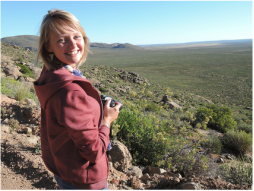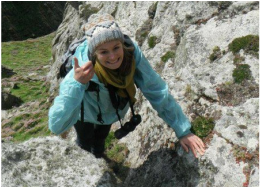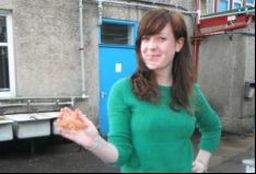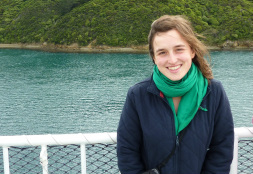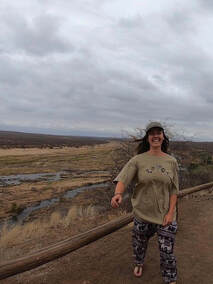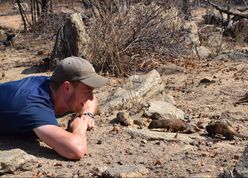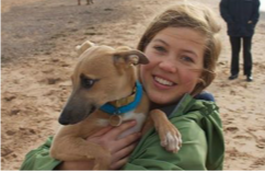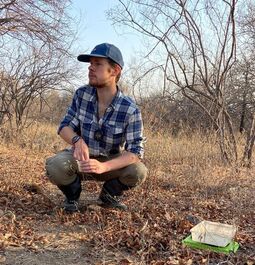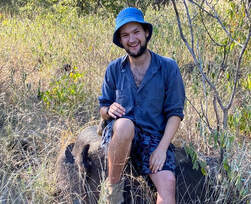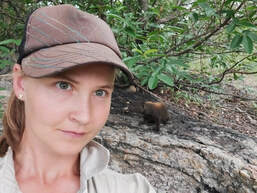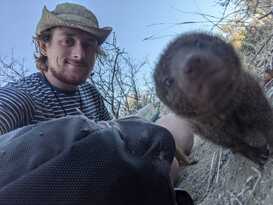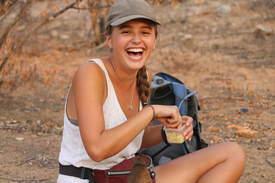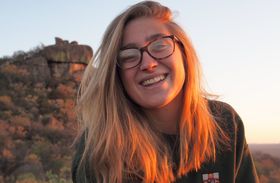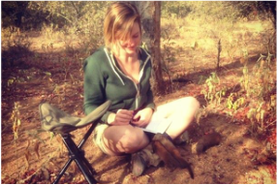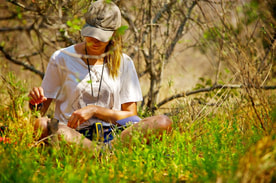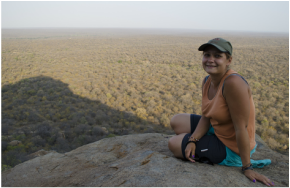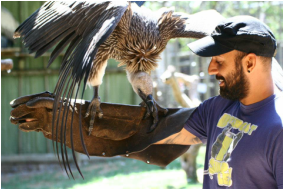Current team members
Professor Andy Radford
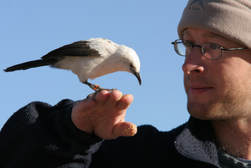
Principal investigator ([email protected])
Andy has long been fascinated by the behaviour and vocalisations of social animals. From his PhD onwards, he has used a combination of observational data, sound recordings and experimental manipulations on wild populations of cooperatively breeding African birds to considerhow vocalisations mediate cooperation and conflict. His research group now work on a broad range of taxa, including birds, fish, social insects and mammals, with the Dwarf Mongoose Research Project at the core. Current research interests include information reliability, interspecific eavesdropping, the benefits of 'friendships', and the consequences of out-group conflict; the latter is the focus of his 5-year ERC Consolidator Grant.
Andy has long been fascinated by the behaviour and vocalisations of social animals. From his PhD onwards, he has used a combination of observational data, sound recordings and experimental manipulations on wild populations of cooperatively breeding African birds to considerhow vocalisations mediate cooperation and conflict. His research group now work on a broad range of taxa, including birds, fish, social insects and mammals, with the Dwarf Mongoose Research Project at the core. Current research interests include information reliability, interspecific eavesdropping, the benefits of 'friendships', and the consequences of out-group conflict; the latter is the focus of his 5-year ERC Consolidator Grant.
Dr Julie Kern
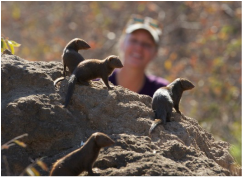
Postdoctoral Research Associate, 2016-2018 ([email protected])
Julie set up the Dwarf Mongoose Research Project in 2011 and subsequently conducted her MSc on sentinel behaviour in the population. She completed her PhD on the species in July 2016, investigating flexible receiver responses to anti-predator vocalisations in the species. She examined the influence of caller identity, exploring effects of signaller class and reliability, as well as the influence of social bond strength between signallers and receivers. She also investigated the effect of situational variability on signal response, including fluctuations in background risk, individual satiation, and groupmate behaviour, as well as the impacts of anthropogenic noise. She returned for 16 months of postdoctoral research on the project where she investigated biological markets, specifically focusing on the exchange of sentinel and grooming behaviour, as well as using social network analysis to examine the social relationships within groups. She continues to be involved alongside other projects, investigating long-term datasets and movement data.
Julie set up the Dwarf Mongoose Research Project in 2011 and subsequently conducted her MSc on sentinel behaviour in the population. She completed her PhD on the species in July 2016, investigating flexible receiver responses to anti-predator vocalisations in the species. She examined the influence of caller identity, exploring effects of signaller class and reliability, as well as the influence of social bond strength between signallers and receivers. She also investigated the effect of situational variability on signal response, including fluctuations in background risk, individual satiation, and groupmate behaviour, as well as the impacts of anthropogenic noise. She returned for 16 months of postdoctoral research on the project where she investigated biological markets, specifically focusing on the exchange of sentinel and grooming behaviour, as well as using social network analysis to examine the social relationships within groups. She continues to be involved alongside other projects, investigating long-term datasets and movement data.
Dr Amy Morris-Drake
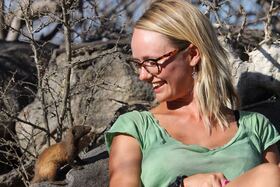
Postdoctoral Research Associate ([email protected])
PhD Student, 2017-2020
Returning to the project after completing her MSc on the cross-modal impacts of anthropogenic noise on dwarf mongooses in 2016, Amy is conducting a PhD on out-group conflict and its consequences. To date, research has focussed on the immediate defensive responses to out-group threats, but how such conflict affects within-group behaviour in the aftermath has received little attention. By conducting behavioural observations, experimental manipulations and analysing long-term data, Amy hopes to unravel the lasting behavioural impacts of out-group conflict in dwarf mongooses.
PhD Student, 2017-2020
Returning to the project after completing her MSc on the cross-modal impacts of anthropogenic noise on dwarf mongooses in 2016, Amy is conducting a PhD on out-group conflict and its consequences. To date, research has focussed on the immediate defensive responses to out-group threats, but how such conflict affects within-group behaviour in the aftermath has received little attention. By conducting behavioural observations, experimental manipulations and analysing long-term data, Amy hopes to unravel the lasting behavioural impacts of out-group conflict in dwarf mongooses.
Natalie Tegtman
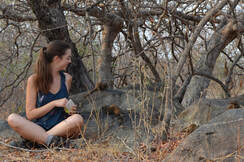
PhD student, Australian National University, 2019-2022 ([email protected])
Natalie is conducting her PhD through the Australian National University under the supervision of Professor Rob Magrath, co-supervised by Professor Andy Radford. Her PhD is looking at how animals assess risk using both personal and social information. She is investigating this in two social species, dwarf mongooses in South Africa and superb fairy-wrens in Australia. In the dwarf mongooses, her work focusses on how the presence of a sentinel affects anti-predatory responses to alarm calls.
Natalie is conducting her PhD through the Australian National University under the supervision of Professor Rob Magrath, co-supervised by Professor Andy Radford. Her PhD is looking at how animals assess risk using both personal and social information. She is investigating this in two social species, dwarf mongooses in South Africa and superb fairy-wrens in Australia. In the dwarf mongooses, her work focusses on how the presence of a sentinel affects anti-predatory responses to alarm calls.
Ben Cobb
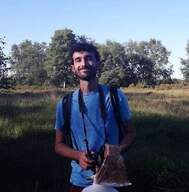
PhD student, 2019-2022 ([email protected])
Ben started his PhD with us after graduating from his BSc at Bristol a couple of months before. He is broadly interested in leadership, group movements and vocal behaviour in dwarf mongooses. In particular, he is focusing on three main questions: how vocalisations are used to recruit followers, how the identity of the leader affects a follower response, and finally, how the threat of out-group conflict might affect a response to a leader's movement call.
Ben started his PhD with us after graduating from his BSc at Bristol a couple of months before. He is broadly interested in leadership, group movements and vocal behaviour in dwarf mongooses. In particular, he is focusing on three main questions: how vocalisations are used to recruit followers, how the identity of the leader affects a follower response, and finally, how the threat of out-group conflict might affect a response to a leader's movement call.
Lucy Westover
MSc student, 2021-2022 ([email protected])
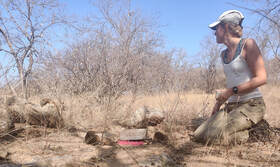
Lucy has jumped straight into her masters research having recently completed her BSc at Bristol. Her research involves using both the long-term database and data she collected in the field. Using the long-term database, she is investigating the impacts that rainfall and temperature have on the behaviour of the dwarf mongooses. In the field she is using playback experiments to look at the immediate effects of anthropogenic noise and predation risk on foraging and vigilance behaviour.
Megan Layton

Specialist Technician, 2021-2022 ([email protected])
Megan has taken up a new position as specialist technician after previously having completed two
long-term stints in the field as project manager. Her new position involves managing the day-to-day running of the project and conducting analyses of the long-term datasets. She is particularly
interested in investigating the use of sleeping burrows and to understand what makes the groups favourite burrows so unique.
Megan has taken up a new position as specialist technician after previously having completed two
long-term stints in the field as project manager. Her new position involves managing the day-to-day running of the project and conducting analyses of the long-term datasets. She is particularly
interested in investigating the use of sleeping burrows and to understand what makes the groups favourite burrows so unique.
Past Team Members
Postgraduate students
Emily Grout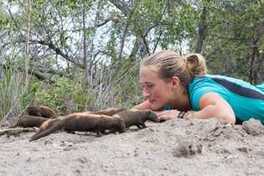
MSc student 2018-2019 ([email protected])
After spending five months as a research assistant for the project in 2017, Emily returned to study dwarf mongoose social behaviour for her MSc. She examined the relationship between adults and pups and collected observational data on their social interactions as well as conducting experiments to understand whether adults show preferences for feeding and grooming particular pups. Josh Arbon |
Emily Richens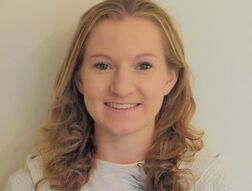
MSc student 2017-2019 ([email protected])
Emily finished her BSc at Bristol in 2017 before jumping straight back into university life, beginning her MSc in Sept 2017. Emily investigated various impacts of anthropogenic noise on dwarf mongoose behaviour, focusing on their habitat use and refuge choice. Emma Eastcott |
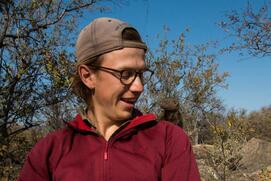
MSc student 2017-2018 ([email protected])
Having completed his undergraduate at Bristol in 2016, Josh came to the project off the back of a year working in VR/wildlife film. His research focused on sentinel behaviour, using playback experiments to investigate whether sentinels can mitigate some of the costs of the behaviour by gathering social information about food availability and patch quality. He is also using faecal sample microsatellite analysis, to gain accurate relatedness estimates for the study population. Using a non-invasive sampling technique, genetic relationships between individuals will be obtained, giving an insight into the relatedness structure of groups, as well as the population as a whole. This will garner valuable insights into subordinate and inter-group matings, and give greater explanatory power to analyses of costs and investments. Josh is now conducting his PhD at the University of Exeter. |
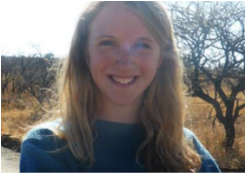
MSc student 2016-2017 ([email protected])
As a growing environmental pollutant, there has been a recent increase in the number of studies investigating the effect of anthropogenic noise on wildlife. Many papers examine the effect on vocal communication, but a few recent studies have established that noise can have detrimental effects on other modalities, such as olfaction. Emma's research focused on how noise may affect cognitive processes such as decision-making and memory, and is looking at the effect of noise on two crucial behaviours: foraging and sentinel behaviour, using playback experiments. |
Amy Morris-Drake |
Charlotte Christensen |
|
MSc student 2014-2016 ([email protected])
|
MSc student 2014-2015 ([email protected])
|
|
MSc student, 2013-2014 ([email protected])
|
MSc student, 2013-2014 ([email protected])
|
Katie CollierPhD student, University of Zurich 2012- 2016 ([email protected])
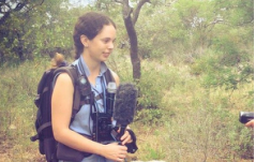
Katie conducted her PhD through the University of Zurich under the supervision of Professor Marta Manser and Dr Simon Townsend. Her work focused on vocal communication and language evolution in social mongooses, inolving fieldwork on dwarf mongooses and meerkats.
|
Amy Sibun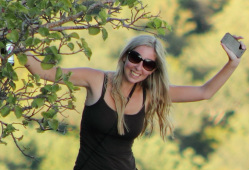
MSc student, 2012-2013 ([email protected])
Amy's research focused on the grooming and foraging behaviour of dwarf mongooses, and whether individuals have a preference for companions for the respective behaviours. She conducted in depth analysis to determine whether there was a correlation between these preferences, in order to work out if dwarf mongooses have long-term preferred companions, thus forming 'cliques' within family groups. |
Undergraduate students
Izzy Carpenter |
Harry Suter |
|
ASAB summer studentship student, 2019
|
ASAB summer studentship student, 2017
|
Katie Rapson |
Pip Laker |
|
ASAB summer studentship student, 2015
|
ASAB summer studentship student, 2014
|
Project Managers
Tom Lewis
Welcome to our new project manager!
Tom comes with experience of working with larger carnivores in Malawi.
Welcome to our new project manager!
Tom comes with experience of working with larger carnivores in Malawi.
|
Kier Kemp
Kier has moved onto drier ground after completing his masters project on bottlenose dolphins at the University of Bristol. |
Lindy Wolhuter
Lindy did a fantastic job at keeping the project going during Covid-19. She came to us having completed a 6 month field stint studying the behaviour of bush Karoo rats for her MSc. |
|
Will Guerrini
A massive thank you to Will who decided, during lockdown in South Africa, to stay on and take the step from RA to PM. He now knows the goosies inside out and has become a fully-fledged mongoose whisperer, evidenced by this awesome photo! |
Megan Layton
Megan came to the project with extensive fieldwork experience from the Alps to the Kalahari. Before working with us, she was the field manager at the Kalahari Mole-rat Project in South Africa. |
|
Jenny Linden
Jenny returned in January 2019 to manage the project after a five month stint as a research assistant in 2018. She is now studying for an MRes in Biodiversity, Evolution and Conservation at UCL. |
Sophie Manson
Sophie returned as project manager after completing her MSci at the University of Bristol in July 2017. She is now working for the Little Fireface Project in Indonesia as their field station coordinator. |
|
Anna Bracken
Anna, also an ex mongoose MSc student, returned to manage the project while conducting further research into her area of interest - the use of heterospecific alarm calls. She is now conducting a PhD with Dr Andy King at Swansea University. |
Charlotte Christensen
Charlotte brought a depth of mongoose experience with her when she returned to manage the project after completion of her MSc. She is now conducting a PhD with Dr Ines Fuertbauer at Swansea University. |
|
Dr Emily Bennitt
Emily brought much fieldwork experience to the project having completed her PhD on the ecology of buffalo in the Okavango Delta. She now heads her own research group at the University of Botswana's Okavango Research Institute. |
Nate Thavarajah
Nate came to us with several years' experience at the Kalahari Meerkat Project. Nate went on to conduct his PhD on sexual selection in peacocks at Manchester University. |
Research Assistants
Many thanks to all our wonderful research assistants past and present. We couldn't do any of it without you!
Rosie Miles, Miriam Fenkes, Megan Shersby, Hayley Muir, Amy Morris-Drake, Charlotte Christensen, Sophie Le Butt, Sophie Edwards, Xiana Batallan, Bryony Davison, Fiona Carr, Emma Ackerley, Duncan Edgeley, Katie Rapson, Sarah Roberts, Anna Bracken, Alice Lawrence, Naomi Terry, Jack Browne, Olivia Dellow, Alice Morrell, Billy Morris, Hayley McLennan, Sophie Manson, Alice Chamberlain, Antony Brown, Jenny Lackie, Robbie Birkett, Emily Howland, Rowan Thomas, Katie Collier, Harry Suter, Alanah Lewis, Izzy Jarold, Tecla Mohr, Emily Grout, Jenny Linden, Hannah Rickets, Aidan Byrne, Frazer Bayliss, Declan Lagan, Olivia Niedzialek, Katie Hollingworth, Lizzie Senior, Robyn Thomson, Maddie Heap, Alexandra Fergusen, Isobel Shan, Guy Burstein, Lucy Collingwood, Will Guerrini, Charlie Cobb, Justin Jacobs, Lindy Wolhuter, Andrea Dixon, Nonkululeko Msomi, Luke Foster, Michele ter Huurne, Sbongile Moyana, Michell Masanabo, Precious Ndou, Kgahlisho Hlahla, Gontse Diale, Merril Grobler, Francesca Osello, Pauline Boigelot, Alexandre Croset, Nina Jerome, Ella Ronan, Matilda Southgate, Abi Brown, Holly Mardel, Holly Appleby, Karl Finn, Myrto Petropoulou
Rosie Miles, Miriam Fenkes, Megan Shersby, Hayley Muir, Amy Morris-Drake, Charlotte Christensen, Sophie Le Butt, Sophie Edwards, Xiana Batallan, Bryony Davison, Fiona Carr, Emma Ackerley, Duncan Edgeley, Katie Rapson, Sarah Roberts, Anna Bracken, Alice Lawrence, Naomi Terry, Jack Browne, Olivia Dellow, Alice Morrell, Billy Morris, Hayley McLennan, Sophie Manson, Alice Chamberlain, Antony Brown, Jenny Lackie, Robbie Birkett, Emily Howland, Rowan Thomas, Katie Collier, Harry Suter, Alanah Lewis, Izzy Jarold, Tecla Mohr, Emily Grout, Jenny Linden, Hannah Rickets, Aidan Byrne, Frazer Bayliss, Declan Lagan, Olivia Niedzialek, Katie Hollingworth, Lizzie Senior, Robyn Thomson, Maddie Heap, Alexandra Fergusen, Isobel Shan, Guy Burstein, Lucy Collingwood, Will Guerrini, Charlie Cobb, Justin Jacobs, Lindy Wolhuter, Andrea Dixon, Nonkululeko Msomi, Luke Foster, Michele ter Huurne, Sbongile Moyana, Michell Masanabo, Precious Ndou, Kgahlisho Hlahla, Gontse Diale, Merril Grobler, Francesca Osello, Pauline Boigelot, Alexandre Croset, Nina Jerome, Ella Ronan, Matilda Southgate, Abi Brown, Holly Mardel, Holly Appleby, Karl Finn, Myrto Petropoulou

